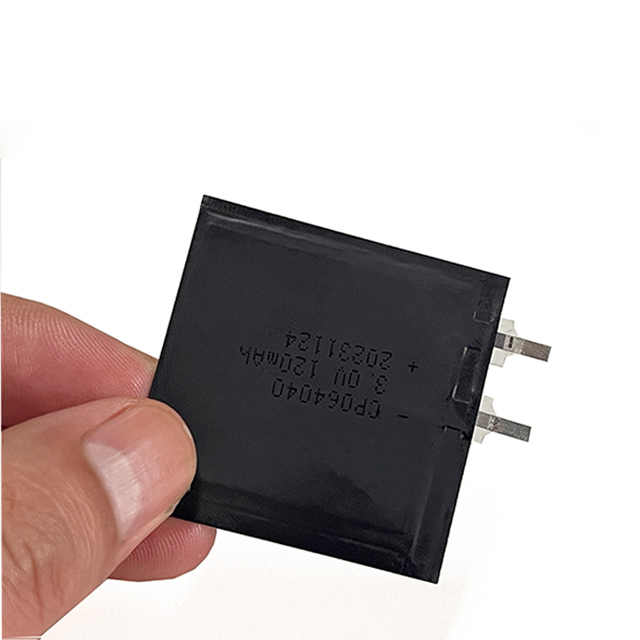Ultra-Thin Flexible Lithium-Manganese Batteries for Smart Financial Cards
Ultra-Thin Flexible Lithium-Manganese Batteries for Smart Financial Cards

In the rapidly evolving world of smart technology, the demand for compact and high-performance power sources is increasing exponentially. The integration of batteries into thin and lightweight devices, such as smart financial cards, has become a significant challenge for manufacturers. However, the advent of ultra-thin flexible lithium-manganese batteries has revolutionized this landscape, offering unparalleled advantages in terms of size, energy density, and safety.
The Quest for Thinness
The quest for thinner and lighter devices has been a driving force in the development of new battery technologies. In the realm of smart financial cards, where every millimeter of thickness matters, the introduction of ultra-thin batteries has been a game-changer. These batteries, with a thickness of ≤0.45mm, can be easily integrated into cards with a total thickness of 0.75mm, making them suitable for a wide range of applications, including contactless payment cards, identity cards, and access control systems.
The ability to customize the battery's dimensions according to the customer's needs is another significant advantage. This flexibility in design ensures that the battery can be seamlessly incorporated into any smart card design, without compromising on performance or safety.
The Power of High Energy Density
The real star of these ultra-thin batteries is their exceptional energy density. Reaching over 400wh/kg, these batteries offer significantly more power than traditional batteries in the same space. This means that smart cards powered by these batteries can perform a wider range of functions, including more complex calculations, data storage, and communication tasks, all while maintaining a sleek and compact design.
The high energy density is achieved through the use of advanced battery chemistry and innovative manufacturing techniques. Lithium-manganese batteries, in particular, are known for their high energy capacity and stability, making them ideal for use in thin and flexible form factors.
Long-Lasting and Reliable
In addition to their impressive energy density, these ultra-thin batteries also boast excellent longevity and reliability. With a self-discharge rate of less than 1% per year, these batteries can maintain their charge for extended periods, even when not in use. This makes them ideal for applications where the card may be stored for long periods before being used again, such as in emergency identification cards or pre-paid transportation cards.
Moreover, the batteries' storage life can exceed 10 years, ensuring that the card will continue to function reliably for many years to come. This longevity is achieved through the use of high-quality materials and rigorous manufacturing processes, which ensure that the battery maintains its performance over time.
Safety First
In any battery-powered device, safety is always a paramount concern. The ultra-thin lithium-manganese batteries used in smart financial cards are designed with safety as a top priority. The high-safety design eliminates the risks associated with battery aging, such as gas bloating and electrolyte leakage, which can pose significant safety hazards.
Furthermore, the batteries are designed to withstand extreme conditions, such as short circuits, overheating, and physical impacts. Even in the event of misuse or abuse, the batteries are unlikely to explode or catch fire, providing users with a high level of protection.
This safety record is achieved through the use of advanced materials and protective mechanisms. The batteries are enclosed in a robust yet flexible casing that can withstand impacts and punctures. Additionally, internal safety features, such as overcharge and overdischarge protection, help to prevent potential hazards and ensure that the battery operates safely at all times.
The Future of Smart Cards
The integration of ultra-thin lithium-manganese batteries into smart financial cards represents a significant step forward in the evolution of these devices. With their high energy density, long-lasting performance, and exceptional safety features, these batteries enable smart cards to perform more complex tasks and offer users a more convenient and secure experience.
In the future, we can expect to see further innovations in battery technology that will push the boundaries of what is possible in smart card design. As battery technology continues to advance, we may see even thinner and more powerful batteries that can be used to power a wider range of devices and applications.
The potential applications of these ultra-thin batteries are vast. They could be used to power wearable devices, such as smartwatches and fitness trackers, providing users with continuous monitoring and data analysis capabilities. They could also be used in medical devices, such as implantable sensors and monitoring systems, enabling real-time health monitoring and data collection.
Overall, the development of ultra-thin lithium-manganese batteries represents a significant milestone in the evolution of smart card technology.





